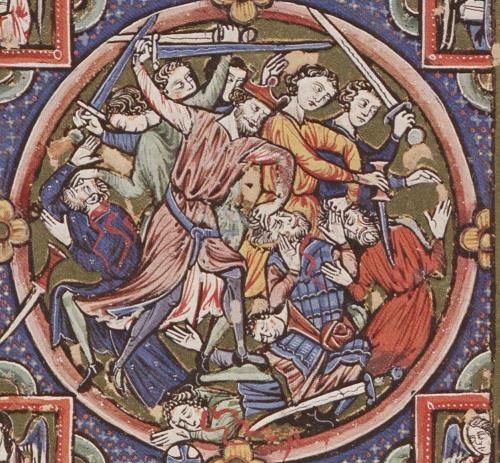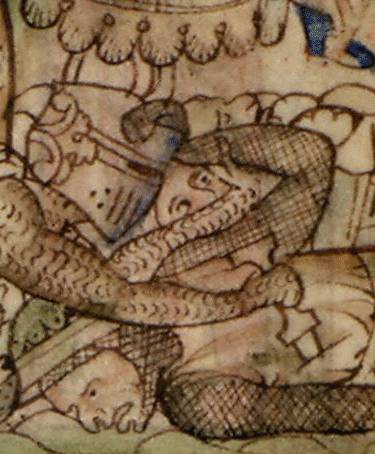| Author |
Message |
Craig Peters

|
 Posted: Sun 11 May, 2014 11:03 pm Post subject: Seax or Dagger Posted: Sun 11 May, 2014 11:03 pm Post subject: Seax or Dagger |
 |
|
I came across the following image from Manuscript Miniatures. It's from the ONB Han. Cod. 2554 Bible Moralisee, dated to 1225-1249. What I am wondering about are the small blades shown in this image. Are they a form of seax? Or are they a sort of proto-baselard or baselard with a single-edged blade? As far as I know, seaxes do not normally have such a stark hour-glass profile for the grip. However, I discovered recently, seaxes are shown in use as late as circa 1194-1196 AD in the Liber ad Honorem Augusti manuscript, so one cannot rule them out as seaxes either.
What are your views?
Link to the original image here: http://manuscriptminiatures.com/4748/10693/
 Attachment: 71.48 KB Attachment: 71.48 KB

|
|
  |
 |
|
Peter Johnsson
Industry Professional
|
 Posted: Sun 11 May, 2014 11:46 pm Post subject: Posted: Sun 11 May, 2014 11:46 pm Post subject: |
 |
|
Very nice find. To me these look like single edged daggers in a mounting that we recognize in early forms of the basilard.
Beautiful form and interesting dating!
|
|
   |
 |
|
Lukas MG
Industry Professional
|
 Posted: Mon 12 May, 2014 12:34 am Post subject: Posted: Mon 12 May, 2014 12:34 am Post subject: |
 |
|
|
What intrigues me is that curved (?) sword at the bottom of the picture... I don't think I've seen anything like that before in period art.
|
|
   |
 |
|
Stephen Curtin
|
 Posted: Mon 12 May, 2014 12:43 am Post subject: Posted: Mon 12 May, 2014 12:43 am Post subject: |
 |
|
| Lukas MG wrote: | | What intrigues me is that curved (?) sword at the bottom of the picture... I don't think I've seen anything like that before in period art. |
Perhaps this isn't a curved sword, but a straight one which has been bent. As for the seax/dagger question. My vote is for dagger.
Éirinn go Brách
|
|
   |
 |
Craig Peters

|
 Posted: Mon 12 May, 2014 1:50 am Post subject: Posted: Mon 12 May, 2014 1:50 am Post subject: |
 |
|
| Lukas MG wrote: | | What intrigues me is that curved (?) sword at the bottom of the picture... I don't think I've seen anything like that before in period art. |
Lukas,
Swords like these are actually surprisingly common in 13th and 14th century artwork. I don't mean they're "surprisingly common" in the sense that one sees them very regularly. What I mean is that you will see several instances of them in art if you browse through Manuscripts Miniatures. A sword with a blade like this is not an interesting anomaly that you find in only a single manuscript; there are others if you keep looking.
|
|
  |
 |
Boris Bedrosov
Industry Professional

Location: Bourgas, Bulgaria Joined: 06 Nov 2005
Posts: 700
|
 Posted: Mon 12 May, 2014 12:45 pm Post subject: Posted: Mon 12 May, 2014 12:45 pm Post subject: |
 |
|
I'll back Craig - they were indeed common - just for reference, when have time take a look here
http://sword-site.com/thread/99/byzantine-swo...rollTo=280
to find a great number of paramerhions (sabres/curved swords), shown in art; and all these - only in Byzantium and the Byzantine-influenced world.
Regarding the dagger, it could really be some sort of proto-baselard. But also I could see some features of Islamic daggers - mainly the curved blade and the pronounced hour-glass grip.
Well, although speculative I have that feeling of strong Islamic influence here.
BTW - what is the context of the image?
"Everyone who has the right to wear a long sword, has to remember that his sword is his soul,
and he has to separate from it when he separates from his life"
Tokugawa Ieyasu
Find my works on Facebook:
Boris Bedrosov's Armoury
|
|
   |
 |
|
Phil D.
|
 Posted: Mon 12 May, 2014 1:04 pm Post subject: Posted: Mon 12 May, 2014 1:04 pm Post subject: |
 |
|
Good eye Boris. Definitely looks Jambiya-ish.
"A bottle of wine contains more philosophy than all the books in the world." -- Louis Pasteur
"A gentleman should never leave the house without a sharp knife, a good watch, and great hat."
|
|
  |
 |
Elling Polden

|
 Posted: Tue 13 May, 2014 8:08 am Post subject: Posted: Tue 13 May, 2014 8:08 am Post subject: |
 |
|
If you are defining a sax as a knife with the edge on the straight side of the blade, I would say no. Single edged daggers/figthing knifes where very common, probably more so that double edged daggers in most places.
The proto-baselard hilts are seen in other sources from the same period as well.
Seax design also varied with time and place. While british seaxes tended to have the edge on the straight side, frankish ones had a curved back AND edge, the later scandinavian ones a straight back and curved blade more akin to the medevial figthing knifes. Slavic figthing knifes had long, slender blades with paralell edges that curve back to the spine like a modern knife.
Regarding the sword, that spesific manuscript has a quite noticable amount of moorish equipment in it. At one point the artist actually draws a realistic lamellar armour! It is not unlikely that he (as one of the few illustrators) actually had first hand knowledge of moors.
"this [fight] looks curious, almost like a game. See, they are looking around them before they fall, to find a dry spot to fall on, or they are falling on their shields. Can you see blood on their cloths and weapons? No. This must be trickery."
-Reidar Sendeman, from King Sverre's Saga, 1201
|
|
    |
 |
|
Mart Shearer
|
 Posted: Tue 13 May, 2014 9:06 am Post subject: Posted: Tue 13 May, 2014 9:06 am Post subject: |
 |
|
| Craig Peters wrote: | | Lukas MG wrote: | | What intrigues me is that curved (?) sword at the bottom of the picture... I don't think I've seen anything like that before in period art. |
Lukas,
Swords like these are actually surprisingly common in 13th and 14th century artwork. I don't mean they're "surprisingly common" in the sense that one sees them very regularly. What I mean is that you will see several instances of them in art if you browse through Manuscripts Miniatures. A sword with a blade like this is not an interesting anomaly that you find in only a single manuscript; there are others if you keep looking. |
I suspect it's a paramerion, as the Byzantine influence on the fallen figure in the gray armor (epilorikion or jaserant?) and other similar figures in this Bible portrays considerable Byzantine influence.
ONB 2554 is earlier than the following two 13th century sources, anf likely dates from the 1230s based on helmet style. I suspect the proto-baselard is a single-edged knife rather than dagger or seax. Similar hilting appears in Cambridge Ee.3.59, fo.32v from c. 1250, and a single-edged baselard (apparently to "keep the game honest") appears in Alfonso X's Book of Games, T.I.6 fo.66r from 1283.


ferrum ferro acuitur et homo exacuit faciem amici sui
|
|
  |
 |
|
Mart Shearer
|
 Posted: Tue 13 May, 2014 10:03 am Post subject: Posted: Tue 13 May, 2014 10:03 am Post subject: |
 |
|
| Elling Polden wrote: | | Regarding the sword, that spesific manuscript has a quite noticable amount of moorish equipment in it. At one point the artist actually draws a realistic lamellar armour! It is not unlikely that he (as one of the few illustrators) actually had first hand knowledge of moors. |
Considering the manuscript likely dates to the 1220s or 1230s, I suspect the French had seen quite a bit of Byzantine and Egyptian armor during the 4th and 5th Crusades!
| Boris Bedrosov wrote: | | BTW - what is the context of the image? |
The Bible moralisée format is generally 8 roundels of miniatures per page with descriptions in sidebars. 2 roundels generally relate an Old Testament story, and the next 2 draw a moral parallel in the life of Christ. How's your Old French (and ability to read a 13th century script)? 5 short lines of text is about 900kb on the 4.8MB folio from the ÖNB.
ferrum ferro acuitur et homo exacuit faciem amici sui
|
|
  |
 |
Elling Polden

|
 Posted: Tue 13 May, 2014 1:04 pm Post subject: Posted: Tue 13 May, 2014 1:04 pm Post subject: |
 |
|
Mart: One should think so, but If you look at the manuscripts of the age, they suggest that the artists have heard some anecdotes, but have not seen the things themselves.
Take the maciowski bible for example. it is a highly detailed work made by professional illuminators. These might have asked a returning crusader "How do you recognize the heathens?". Where upon the veteran might answer "They have pointed helmets, and round shields."
Consequently the heatens are drawn with pointed helmets and round shields. Everything else is identical to the "default" contemporary standard, because they simply do not know.
In the same spirit, they draw the egyptian chariots of pharaos army as 13th century french haywagons.
The artist in the bible moralise has more detailed depictions of moors and moorish equipment than is common for the period. He might indeed be a returned crusader, or traveler of some sort. But the average northwest european would know about as much about the arms and equipment of the moors as a contemporary american knows of the North Vietnamese Army.
"this [fight] looks curious, almost like a game. See, they are looking around them before they fall, to find a dry spot to fall on, or they are falling on their shields. Can you see blood on their cloths and weapons? No. This must be trickery."
-Reidar Sendeman, from King Sverre's Saga, 1201
|
|
    |
 |
|
|

